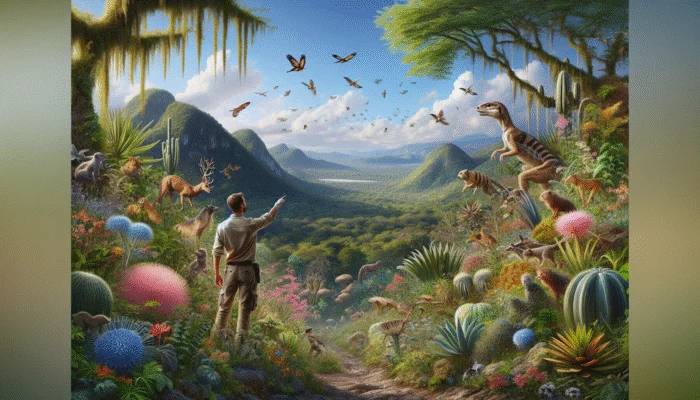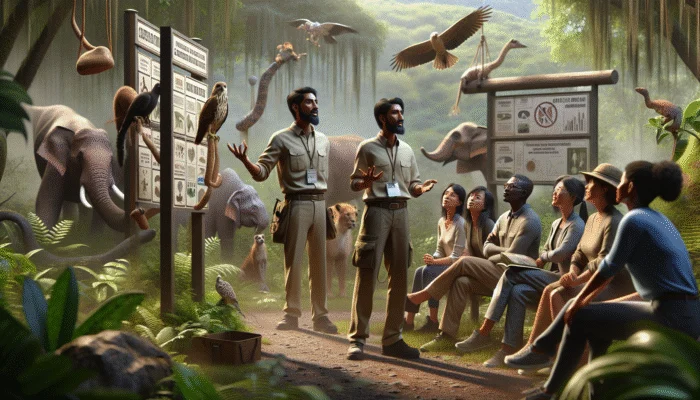Discover the Thrilling Adventure of Wildlife Tours in San Miguel de Allende
What Unique Features Make San Miguel de Allende Wildlife Tours Stand Out?

San Miguel de Allende Wildlife Tours provide unmatched, immersive experiences that transport adventurers into the stunning landscapes of nature, highlighting the region’s remarkable biodiversity. These tours cater to those eager to uncover the intricate ecosystems surrounding San Miguel de Allende, ensuring that every participant departs with a greater appreciation and understanding of both wildlife and conservation initiatives. Typically, these vibrant tours are led by knowledgeable guides who share their extensive insights into local flora and fauna, turning your adventure into a captivating blend of education and thrill.
- Experience guided explorations of diverse ecosystems.
- Seize firsthand opportunities to observe local wildlife in their natural habitats.
- Gain valuable educational insights from experienced naturalists.
- Engage in meaningful conservation efforts and raise awareness.
- Enjoy flexible itineraries tailored for all ages and fitness levels.
- Immerse yourself in unique cultural interactions with local communities.
- Capture breathtaking wildlife moments through photography opportunities.
These customized experiences cater to nature lovers, families, and solo explorers, transforming an ordinary outing into an exciting adventure filled with discovery and wonder.
What Draws Nature Enthusiasts to Wildlife Tours?
The appeal of wildlife tours stems from their ability to foster a profound connection between individuals and the natural environment, enabling participants to witness the breathtaking beauty of wildlife up close. Tourists from all walks of life, whether families seeking educational experiences or solo adventurers in search of extraordinary encounters, derive immense pleasure from observing the intricate behaviors of animals in their natural habitats. These tours seamlessly blend family fun with educational components, making them suitable for everyone, from inquisitive children to adventurous retirees.
The thrill of spotting a rare bird or a family of deer in their natural surroundings sparks excitement among participants. Each sighting deepens the understanding of the delicate balance maintained within ecosystems and highlights the crucial importance of biodiversity. Learning about conservation efforts and each species’s role in their environment enriches the overall experience, elevating it beyond just a sightseeing venture.
How Should You Prepare for Your Wildlife Tour to Maximize the Experience?
Preparation is essential to optimize your experience on a wildlife tour. Understanding the necessary gear and safety precautions can significantly enhance your adventure. Being ready for fluctuating weather conditions and varied terrains is vital for a memorable experience. Knowing what to pack ensures you’re well-prepared to handle the tour, allowing you to concentrate on soaking in the beauty around you rather than worrying about comfort or safety.
- Wear comfortable clothing appropriate for the weather.
- Select durable hiking boots suited for varied terrain.
- Bring binoculars to enhance your wildlife observation.
- Carry a camera or smartphone to capture lasting memories.
- Have a water bottle handy to stay hydrated throughout the journey.
- Pack light snacks to keep your energy levels up during the tour.
- Utilize bug spray and sunscreen for protection against the elements.
- Bring a daypack to conveniently carry your essentials.
Equipping yourself with the right gear not only enhances your comfort but also ensures you’re ready for any unexpected situations. By being well-prepared and knowing what to expect, you can fully immerse yourself in the adventure that lies ahead.
Insights from Experts on San Miguel de Allende Wildlife Tours

What Qualifications Should You Look for in a Wildlife Tour Guide?
A proficient expert in wildlife tours possesses a comprehensive understanding of local ecosystems, animal behaviors, and conservation strategies. Their expertise is crucial in ensuring that participants have a safe and informative experience. When selecting a guide, seek individuals with relevant experience, educational backgrounds in ecology or wildlife biology, and a genuine passion for conservation. Their knowledge empowers them to provide valuable insights that greatly enhance the overall tour experience.
To identify a qualified guide, consider these actionable steps: conduct thorough online research to read reviews, inquire about their training and certifications, ask about their field experience, and confirm they adhere to ethical wildlife viewing practices. Engaging with an expert not only enhances your experience but also deepens your understanding of the intricate relationships within ecosystems.
How Do Experts Enrich Your Wildlife Tour Experience?
Experts greatly enhance wildlife tours through their vast knowledge and ability to provide contextual information. They function as educators, imparting detailed insights about the species encountered, the ecological significance of various habitats, and the latest conservation efforts. Their expertise can transform a routine walk into an engaging learning experience, igniting curiosity and fostering a deeper appreciation for nature.
Additionally, experts create a more interactive environment by addressing questions, encouraging discussions, and sharing personal anecdotes from their field experiences. This engaging format allows participants to explore topics that pique their interest, creating connections not only with the wildlife but also with the land and its preservation efforts. With an expert guide, every wildlife tour becomes an opportunity for exploration and growth.
How Can You Seamlessly Incorporate Expert Knowledge During Your Tours?

The most rewarding Wildlife tours are those that effectively interweave expert knowledge throughout every aspect of the experience. When guides share scientific data, historical insights, and current conservation challenges, participants gain a comprehensive understanding of the biodiversity surrounding them. This educational layer elevates the experience, instilling a sense of responsibility towards environmental stewardship.
Moreover, guided discussions regarding local conservation initiatives and ways to support wildlife protection create a participatory atmosphere. This engagement fosters awareness and provides opportunities for participants to contribute to conservation efforts, whether through volunteering, donating, or simply spreading knowledge about the importance of preserving natural habitats. Such integration of expert knowledge transforms participants into informed advocates for wildlife conservation.
Explore the Richness of Wildlife on Tours
What Common Species Can You Expect to Encounter on Wildlife Tours?
During wildlife tours, participants can anticipate encountering a remarkable variety of species, each playing a unique role within the ecosystem. From vibrant birds flitting through the treetops to mammals weaving through the underbrush, the diversity offers an exhilarating experience for nature lovers. Common species typically include various deer species, foxes, and numerous bird species inhabiting the region.
Understanding the specifics of what you may encounter enhances your anticipation and prepares you for the adventure ahead. Although many tours focus on familiar species, every sighting contributes to the overall richness of the experience. Guides often provide insights into the behaviors and characteristics of these animals, adding context to your observations. Engaging with local fauna paints a vivid picture of life in the wild, making your journey not just an outing but an enlightening expedition.
What Are Some of the Rarest Animals You Might Encounter?
While the excitement of spotting common wildlife is undeniable, the chance to encounter rare species often becomes the highlight of any wildlife tour. The thrill of seeing a rare bird or elusive mammal can create unforgettable memories. Rarer species may include the elusive jaguar or endangered birds unique to Mexico, which might only appear under specific conditions.
Participants should remain vigilant and engaged, as these rare sightings often require patience and a bit of luck. Tours may sometimes focus on specific locations known for rare encounters, and guides typically share tips on the best practices for spotting these elusive creatures. The thrill of encountering rare wildlife not only creates lasting memories but also reinforces the importance of conservation efforts aimed at protecting these vulnerable species.
How Do Seasonal Changes Affect Wildlife Sightings?
Wildlife sightings can vary significantly based on seasonal patterns, making timing a crucial factor for those planning a wildlife tour. Seasonal changes influence animal behavior, migration, and breeding cycles, directly impacting what can be observed during a tour. Understanding these variations allows participants to plan their tours for optimal wildlife viewing experiences.
For instance, certain bird species may be more visible in spring during migration, while mammals could be more active in autumn as they prepare for winter. Knowledge of these seasonal dynamics enhances the overall experience by aligning expectations with the realities of wildlife behavior. Engaging guides who comprehend these patterns ensures that the tour remains both productive and enjoyable, maximizing your wildlife encounters.
What Are the Key Benefits of Wildlife Tours in San Miguel de Allende?
What Learning Opportunities Are Offered by Wildlife Tours?
The educational value of wildlife tours is immense, providing participants with hands-on insights into ecosystems, species interactions, and the critical importance of biodiversity. These tours offer immersive learning experiences that deepen participants’ appreciation for nature while fostering environmental awareness. Guides often share captivating stories and scientific facts, which enrich the learning process.
Moreover, these tours stimulate curiosity and engagement, encouraging participants to ask questions and explore topics related to conservation and ecology. This interactive learning format allows individuals to connect with nature on a deeper level, promoting not only awareness but also a sense of responsibility towards environmental stewardship. The knowledge gained during these tours often inspires participants to become advocates for wildlife conservation within their communities.
How Do Wildlife Tours Support Conservation Initiatives?
Wildlife tours serve as a vital link between education and conservation efforts. By informing participants about the ecological significance of various species and the challenges they face, these tours play an essential role in promoting environmental stewardship. Understanding the impacts of habitat loss, climate change, and human activities on wildlife encourages participants to actively support conservation initiatives.
Additionally, many wildlife tour operators contribute a portion of their profits to local conservation projects, creating a direct connection between tourism and the preservation of natural habitats. This model benefits wildlife and supports local communities dedicated to sustainable practices. Through these tours, participants transition from mere observers to integral parts of a larger conservation narrative, fostering awareness and action.
What Health and Wellness Benefits Are Associated with Wildlife Tours?
Interacting with nature through wildlife tours offers significant health benefits, both physically and mentally. Studies have shown that spending time outdoors can lower stress, anxiety, and depression while enhancing overall well-being. The combination of fresh air, physical activity, and the soothing effects of nature creates an ideal environment for relaxation and rejuvenation.
Participating in wildlife tours allows individuals to disconnect from the hustle and bustle of daily life, presenting an opportunity for mindful observation and reflection. This slower pace encourages participants to fully appreciate their surroundings. This reconnection with nature not only enhances mental health but also promotes physical fitness through walking, hiking, and other activities involved in exploring natural habitats.
What Unique Wildlife Encounters Await You on Tours?
San Miguel de Allende wildlife tours are synonymous with unique wildlife encounters that leave lasting impressions. The chance to observe diverse species in their natural habitats provides an unparalleled experience that enhances your appreciation for local biodiversity. Each tour presents the opportunity to witness interactions among species, understand ecological dynamics, and marvel at the beauty of nature.
These unique encounters often highlight the significance of conservation efforts. Observing wildlife behaviors and interactions fosters a deeper understanding of the ecological roles these species play and the challenges they face. Such experiences not only create unforgettable memories but also empower participants to advocate for the protection of these environments, emphasizing the vital relationship between tourism and conservation.
How Do Wildlife Tours Benefit Local Economies?
Wildlife tours in San Miguel de Allende provide substantial economic advantages to local communities by generating job opportunities and supporting local businesses. The influx of tourists stimulates economic activity, benefiting local guides, hospitality services, and artisans due to increased demand. This economic boost is crucial for sustaining both the region’s natural and cultural heritage.
Furthermore, by promoting conservation-focused tourism, these tours contribute to protecting and maintaining natural habitats, ensuring local ecosystems remain intact for generations to come. The emphasis on sustainable practices encourages local communities to engage in conservation efforts, creating a symbiotic relationship between tourism, economic development, and environmental stewardship. Through wildlife tours, participants not only enrich their own experiences but also support the livelihoods of local communities and the preservation of biodiversity.
Designing Your Unforgettable San Miguel de Allende Wildlife Tour
What Steps Should You Take to Choose the Perfect Tour?
Selecting the ideal wildlife tour involves careful consideration of various factors to ensure a rewarding experience. Start by evaluating your interests—do you prefer bird watching, mammal spotting, or learning about plant life? Additionally, assess the duration of the tour, the required physical activity level, and specific focus areas of interest.
Aligning the tour with your fitness level is also crucial. Some tours may involve extensive hiking, while others cater to a more leisurely pace. Reading customer reviews and exploring itineraries can provide insights into what each tour offers, helping you make an informed decision. Ultimately, the right choice enhances your experience, ensuring full engagement with the wildlife and natural beauty you encounter.
What Should You Consider When Booking and Managing Logistics?
Booking a wildlife tour requires attention to detail to ensure a seamless and enjoyable experience. Begin by researching reputable tour companies that prioritize conservation and offer engaging itineraries. Once you’ve selected a tour, consider the logistics involved. Confirm transportation arrangements and accommodations, especially for tours that span multiple days or require overnight stays.
Timing is another critical factor—be mindful of peak seasons for wildlife sightings and book early to secure your spot. Preparing for the unexpected, such as weather changes or last-minute adjustments, can further enhance your readiness. Well-organized logistics allow you to focus on the adventure ahead rather than logistical challenges.
What Experiences Can You Expect During Your Wildlife Tour?
Participants can anticipate a delightful blend of activities during a wildlife tour. Guided walks through diverse landscapes typically form the core of the experience, providing opportunities for educational talks led by knowledgeable guides. These informative sessions are designed to offer insights into the species being observed and the ecological significance of the area.
Additionally, expect quiet observation periods where participants can fully immerse themselves in their surroundings and engage in wildlife spotting. Each tour is crafted to balance education, engagement, and leisure, allowing participants to fully appreciate the natural beauty around them. Understanding the itinerary and structure of the tour helps set realistic expectations, ensuring a rewarding and enjoyable experience.
Research-Based Insights on the Benefits of San Miguel de Allende Wildlife Tours
What Do Studies Reveal About the Impact of Wildlife Tours?
Research indicates that wildlife tours significantly enhance participants’ knowledge and appreciation of nature. Studies show that participants leave with a heightened awareness of ecological issues and the critical importance of conservation efforts. This educational impact transforms individual perspectives and fosters a collective responsibility towards wildlife protection and habitat preservation.
Expert analysis of these findings suggests that integrating educational elements into wildlife tours is essential for maximizing their impact. Engaging participants with hands-on learning experiences, such as observing animal behavior or understanding local ecosystems, fosters deeper connections and encourages advocacy for conservation initiatives. These positive outcomes highlight the significance of structured education within the tourism experience.
How Does Exposure to Nature Benefit Psychological Well-Being?
Exposure to nature through wildlife tours is linked to numerous psychological benefits, including reduced stress levels and enhanced overall mental health. Participants frequently report feelings of tranquility and joy while immersed in natural settings, countering the effects of everyday life stressors. Nature’s calming influence promotes mindfulness and encourages individuals to actively engage with their environment.
These psychological benefits extend beyond the duration of the tour; individuals often carry the positive effects into their daily lives. By participating in wildlife tours, individuals not only enhance their mental well-being but also cultivate a lasting connection with nature, inspiring ongoing engagement and advocacy for environmental preservation.
How Do Wildlife Tours Promote Local Economic Development?
Wildlife tours significantly contribute to the economic vitality of local communities by creating job opportunities and supporting small businesses. As tourism increases, local guides, artisans, and service providers benefit from heightened demand, creating a sustainable economic cycle. This economic boost is crucial for maintaining the region’s cultural and environmental integrity.
Moreover, wildlife tourism fosters a sense of ownership among local communities, encouraging them to protect their natural resources. Witnessing the economic advantages of preserving wildlife habitats motivates communities to engage in conservation efforts that benefit both the environment and the local economy. Through wildlife tours, participants support a model of sustainable development that champions both ecological and economic health.
Best Practices for Engaging in Wildlife Tours
What Ethical Guidelines Should Be Followed in Wildlife Tourism?
Ethical wildlife tourism focuses on prioritizing the well-being of animals and the ecosystems they inhabit. This approach emphasizes minimal disturbance to wildlife and adherence to established conservation guidelines. Responsible operators ensure tours respect natural habitats and promote awareness of the consequences of human activity on wildlife.
Tourists should engage with operators who emphasize ethical practices, ensuring their experiences align with sustainability principles. Understanding these ethical considerations fosters a culture of respect and responsibility towards wildlife, encouraging all participants to contribute positively to the ecosystems they visit.
How Can You Minimize Your Impact on Wildlife During Tours?
Minimizing impact during a wildlife tour is crucial for ensuring the sustainability of these experiences. Adopting responsible practices such as maintaining a safe distance from animals, refraining from feeding them, and respecting their natural behaviors is essential. These practices not only support the well-being of wildlife but also enhance the quality of the experience for all participants.
Furthermore, being mindful of noise levels and avoiding littering promotes a clean and safe environment. Engaging with knowledgeable guides can provide insights into the best practices for observing wildlife without causing harm. By prioritizing responsible behavior, participants contribute to the preservation of natural habitats and foster a deeper connection with the wildlife they encounter.
What Sustainable Practices Should Be Incorporated in Wildlife Tours?
Implementing sustainable practices in wildlife tours is essential for ensuring the long-term viability of both tourism and conservation efforts. This includes minimizing waste, utilizing eco-friendly products, and actively supporting local conservation initiatives. Tour operators that prioritize sustainable practices often incorporate educational components that inform participants about the importance of preserving natural habitats.
By engaging in eco-conscious behaviors, tourists can help protect the environments they visit. Practices such as carpooling, using refillable water bottles, and supporting local businesses contribute to a sustainable tourism model that benefits both the environment and local economies. These practices cultivate a sense of responsibility and connection, reinforcing the significance of conservation within the tourism experience.
Mastering Wildlife Photography During Your Tours
What Techniques Can Enhance Your Wildlife Photography Skills?
Capturing stunning wildlife images during wildlife tours requires not only the right equipment but also patience and skill. Understanding animal behavior is crucial for anticipating moments worth capturing, allowing photographers to document interactions and unique behaviors. Techniques such as adjusting shutter speeds and utilizing appropriate lenses can significantly improve image quality.
It’s essential to respect wildlife and their habitats, maintaining a safe distance while using zoom lenses for close-up shots. Practicing patience during observation often leads to the most rewarding photographic opportunities. By blending technical skills with an understanding of wildlife behavior, photographers can enhance their ability to capture the beauty of nature.
How Can Photography Enrich Your Tour Experience?
Photography adds a unique dimension to wildlife tours, transforming the experience from mere observation to active engagement. Documenting moments through photography allows participants to relive their adventures and share them with others, fostering a sense of connection with the natural world. Capturing images encourages mindfulness, prompting individuals to pay closer attention to their surroundings and appreciate the intricate details of wildlife.
Moreover, photography can serve as a powerful tool for advocacy. Sharing stunning images of wildlife raises awareness about conservation issues and inspires others to connect with nature. By integrating photography into the tour experience, participants not only document their journey but also promote the significance of preserving wildlife and their habitats.
What Equipment Is Essential for Wildlife Photography?
When preparing for wildlife photography during tours, having the right equipment is crucial for capturing high-quality images. Essential items typically include a good camera with interchangeable lenses, a telephoto lens for zooming in on distant subjects, and a sturdy tripod to ensure stability during shots. Additional equipment like memory cards, lens cleaning kits, and spare batteries are also vital to keep your gear ready for action.
Understanding what to bring can significantly enhance your photographic opportunities. Familiarizing yourself with your equipment before the tour ensures you can swiftly adjust settings and capture moments as they unfold. Having the right gear not only improves the quality of your photos but also allows you to enjoy the experience without technical difficulties.
Which Locations Are Prime for Wildlife Photography Tours?
Numerous breathtaking destinations worldwide serve as ideal settings for wildlife photography. Locations such as national parks, wildlife reserves, and remote wilderness areas present opportunities to capture diverse species in their natural habitats. Regions like Yellowstone National Park in the USA, the Serengeti in Tanzania, and Costa Rica’s rainforests are renowned for their photographic potential due to their rich biodiversity and stunning landscapes.
When selecting a location for wildlife photography, consider factors such as seasonal patterns of the species you wish to capture, accessibility, and photography-friendly environments. Collaborating with local guides who understand the best spots for photographing wildlife can enhance your experience, providing insights that lead to unforgettable captures. The right location not only enriches your photographic journey but also deepens your connection with the natural world.
Effectively Sharing Your Wildlife Tour Adventure
What Are the Best Ways to Document Your Tour Experience?
Documenting your wildlife tour experience allows you to relive the adventure while sharing it with others. One effective method is to maintain a travel journal where you can record observations, thoughts, and feelings experienced throughout the journey. Including specifics such as wildlife encounters, impressions of the landscape, and personal reflections enhances your narrative.
Additionally, integrating photography into your documentation adds a visual dimension that enriches storytelling. Sharing images alongside your journal entries on social media or personal blogs can inspire others to explore wildlife tours. This documentation process not only preserves memories but also encourages a deeper appreciation for the natural world, prompting ongoing discussions about wildlife conservation and environmental awareness.
How Can You Connect with the Wildlife Tour Community?
Engaging with the community of wildlife tour enthusiasts enriches your overall experience. Connecting with fellow participants and sharing stories, tips, and photographs fosters a sense of camaraderie and collective learning. Online platforms and social media groups dedicated to wildlife tours create spaces for exchanging ideas, experiences, and recommendations for future adventures.
Participating in forums or attending local wildlife events can also deepen your connection to the community. Through these interactions, you can gain insights into diverse wildlife experiences while building relationships with like-minded individuals. Engaging with the wildlife tour community enhances your understanding and inspires a shared commitment to conservation efforts and wildlife protection.
How Can You Inspire Others to Join Wildlife Tours?
Sharing your experiences from wildlife tours can inspire friends, family, and the broader community to participate in similar adventures. Whether through storytelling, photography, or social media posts, your unique encounters can spark interest and curiosity in others. Highlighting the educational and emotional benefits of these tours encourages a broader appreciation for nature and wildlife conservation.
Moreover, by advocating for wildlife tours, you contribute to a culture of awareness and responsibility towards environmental stewardship. Your enthusiasm can motivate others to engage with nature and support conservation initiatives, creating a ripple effect of awareness that extends beyond individual experiences. Inspiring others not only enriches their lives but also fosters a collective commitment to safeguarding wildlife and their habitats.
Frequently Asked Questions About Wildlife Tours
When Is the Best Time to Experience Wildlife Tours in San Miguel de Allende?
The optimal time for wildlife tours in San Miguel de Allende is during the dry season from November to April when wildlife sightings are more frequent, and the weather is generally pleasant.
Are Wildlife Tours Suitable for Young Children?
Yes, many wildlife tours are family-friendly and designed to accommodate children. Check with tour operators for options specifically tailored for younger participants.
What Attire Is Appropriate for a Wildlife Tour?
Wear comfortable, weather-appropriate clothing, sturdy footwear, and bring layers to adapt to changing temperatures. Also, don’t forget a hat and sunscreen for sun protection.
Can I Take Photos During the Tour?
Absolutely! Photography is encouraged during wildlife tours. Just remember to respect wildlife and maintain a safe distance while capturing your shots.
Are All Wildlife Tours Led by Experts?
Yes, all wildlife tours are guided by knowledgeable experts who provide valuable insights into the species and ecosystems you’ll encounter.
Is It Safe to Participate in Wildlife Tours?
Wildlife tours are organized with safety as a priority. Guides ensure participants follow safety protocols and maintain appropriate distances from wildlife.
Do I Need Specialized Equipment for Wildlife Tours?
While basic equipment is often sufficient, binoculars and a camera are recommended to enhance your experience. Comfortable clothing and sturdy shoes are also essential.
How Do Wildlife Tours Support Conservation Initiatives?
Wildlife tours often contribute a portion of their profits to conservation initiatives, promote awareness of ecological issues, and educate participants about protecting natural habitats.
Can I Customize My Wildlife Tour Experience?
Many tour operators offer customizable options to suit individual interests and needs, so inquire about specific itineraries or preferences when booking.
What Types of Wildlife Can I Expect to See in San Miguel de Allende?
Expect to see a variety of species, including birds, mammals like deer and foxes, and occasionally rare species, depending on the season and location of the tour.
The Article: Wildlife Tours in San Miguel de Allende: Nature Lover’s Guide appeared first on https://fallinginlovewithsanmiguel.com/
The Article Wildlife Tours: Your Guide to Nature in San Miguel de Allende Was Found On https://limitsofstrategy.com

